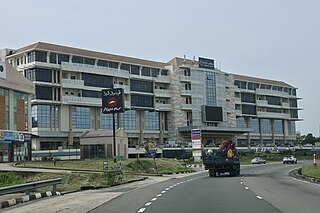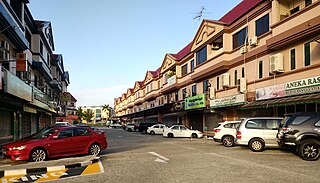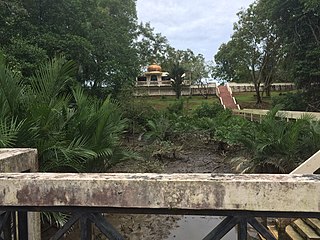
Kampung Ayer is a prominent traditional settlement in Bandar Seri Begawan, the capital of Brunei. It comprises neighbourhoods of traditional houses, schools and mosques built on stilts above the Brunei River near the capital's city centre. It has an area of about 10 square kilometres (3.9 sq mi); the total population was 10,250 in 2016. It has been historically nicknamed 'Venice of the East'.

Mukim Bukit Sawat is a mukim in Belait District, Brunei. It had a population of 794 in 2016.

Mukim Burong Pingai Ayer is a mukim in Brunei-Muara District, Brunei. It is located within Kampong Ayer, the traditional stilt settlements on the Brunei River in the capital Bandar Seri Begawan. The population was 1,770 in 2016.

Mukim Sungai Kebun is a mukim in Brunei–Muara district, Brunei. It is part of Kampong Ayer, the traditional stilt settlements on the Brunei River in the capital Bandar Seri Begawan. The population was 4,750 in 2016.

Mukim Sungai Kedayan was a mukim in Brunei-Muara District, Brunei. It was located within Kampong Ayer, the historical stilt settlements on the Brunei River in the capital Bandar Seri Begawan. The population was 230 in 2016.

Mukim Tanjong Maya is a mukim in Tutong District, Brunei. The population was 4,062 in 2016.

Mukim Bangar is a mukim in Temburong District, Brunei. It has a total area of 113 square kilometres (44 sq mi); the population was 2,112 in 2021. The mukim encompasses Bangar, the district's sole town and administrative centre.

Kampong Lumut or commonly known as Lumut, is a coastal settlement in Belait District, Brunei Daurssalam, about 30 kilometres from the district town Kuala Belait. The total population was 11,273 in 2016.

Kampong Bukit Beruang, also simply known as Bukit Beruang, is a village in Tutong District, Brunei, about 13 kilometres (8.1 mi) from the district town Pekan Tutong. The population was 6,157 in 2016. It is one of the villages within Mukim Telisai, a mukim subdivision in the district. It comprises the original village settlement as well as the public housing estate Bukit Beruang National Housing Scheme.

Kampong Beribi or commonly known as Beribi, is a village in Brunei-Muara District, Brunei, as well as a neighbourhood in the capital Bandar Seri Begawan. The population was 5,679 in 2016. It is one of the villages within Mukim Gadong 'B'. The postcode is BE1118.

Kampong Mata-Mata or commonly known as Mata-Mata, is a village in Brunei-Muara District, Brunei, and a neighbourhood in the capital Bandar Seri Begawan. The population was 6,126 in 2016. It is one of the villages within Mukim Gadong 'B'. The postcode is BE1718.

Kampong Kiulap or commonly known as Kiulap, is a village in Brunei-Muara District, Brunei, as well as a neighbourhood and commercial area in the capital Bandar Seri Begawan. It has an area of 176.53 hectares ; the population was 3,400 in 2016. It is one of the villages within Mukim Gadong 'B'. The postcode is BE1518.

Kampong Kiarong or commonly known as Kiarong, is a village in Brunei-Muara District, Brunei, as well as a neighbourhood in the country's capital Bandar Seri Begawan. It has an area of 383.43 hectares ; the population was 4,530 in 2016.
Kampong Perpindahan Mata-Mata or simply known as Perpindahan Mata-Mata, is a public housing estate and designated village in Brunei-Muara District, Brunei, on the outskirts of the capital Bandar Seri Begawan. The population was 2,385 in 2016. It is one of the villages within Mukim Gadong 'B'. The postcode is BE1918.

Kampong Bunut Perpindahan or also known as Kampong Perpindahan Bunut, is a village in Brunei-Muara District, Brunei, as well as a neighbourhood in the capital Bandar Seri Begawan. The population was 1,707 in 2016. It is one of the villages within Mukim Kilanas. The postcode is BF1220.

Kampong Menglait or simply known as Menglait, is a village in Brunei-Muara District, Brunei, as well as a neighbourhood and commercial area in the capital Bandar Seri Begawan. The population was 2,262 in 2016. It is one of the villages within Mukim Gadong 'B'. The postcode is BE3919.

Kampong Tumasek or simply known as Tumasek, is an area in Bandar Seri Begawan, the capital of Brunei, as well as a village within Mukim Kianggeh in Brunei-Muara District. The population was 673 in 2016. It has the postcode BA2112.
Kampong Bakiau is a village in the north-east of Tutong District, Brunei, about 23 kilometres (14 mi) from the district town Pekan Tutong. It has an area of 1.3 square kilometres (0.50 sq mi); the population was 207 in 2016. It is one of the villages within Mukim Kiudang.

Pengiran Muhammad Ali bin Pengiran Haji Muhammad Daud, simply known as Pengiran Ali, was a Bruneian nobleman, teacher and politician whom formerly held the position of Deputy Menteri Besar from 1962 to 1965, Legislative, Executive, and Privy Councils. He emphasised the significant impact he played in Brunei's history, notably from the 1950s to 1960s, and was also the first of the "three M's" that the British government dreaded.






















